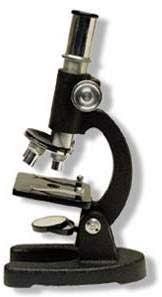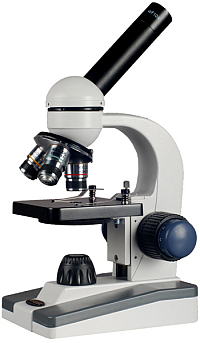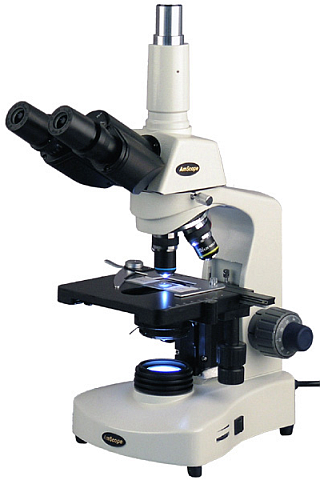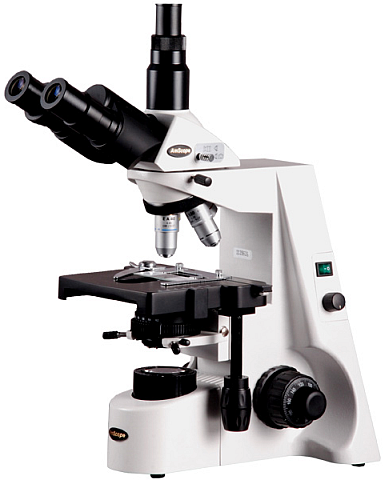exploring the microscopic world is a great hobby!
© 2014 by KV5R. Rev. June 1, 2014
Introduction
Welcome to KV5R’s new microscopy section! In these articles we’ll explore light microscopy from the modern amateur microscopist’s perspective. If you’re interested in amateur microscopy, you’ve come to the right place. The author has spend hundreds of hours researching and collecting the information in these pages, saving the reader a great deal of time and frustration. There is a large amount of microscopy information online that is targeted toward students and professionals—it’s either too shallow or too deep! This series was written to fill that gap by providing an in-depth treatment of the subject that isn’t too technical, yet sufficient for the aspiring adult amateur microscopist. Your comments are welcome and appreciated. Help make it better!
When most people visualize a microscope, any of three images usually come to mind: (1) kids playing with toy microscopes, (2) students in biology labs, and (3) professionals using microscopes. Most people never use a microscope after graduation, unless they go into a scientific or medical career. The highly prevalent view that microscopy is only for students and professionals is strongly held and promoted by universities and professional microscopical societies. Television crime dramas and documentaries continually reinforce this notion by using microscopes as props in nearly every scene of every science lab. The average home is no place for a microscopy lab, right? Well…
Surprise! Microscopy is also a hobby enjoyed by millions worldwide. The amateur microscopist is not a child playing with a toy microscope (though that’s a fine time to start), not a student, and usually not a professional microscopist, but is someone who enjoys a technical hobby just for the fun of expanding the mind. To them, the microscope is a tool that opens wonderful new worlds of inquiry and discovery. Amateur microscopy is like the amateur astronomy, but while one enjoys observing things very large and far away, the other enjoys observing things very small and nearby. Both enjoy science, discovery, optical instruments, and even digital photography and image processing and sharing. But microscopists have an advantage over astronomers: while one sees billions of unreachable objects, the other has ready access to an almost infinite number of otherwise unseen objects, including millions of tiny lifeforms, in detail. Whole new sub-millimeter worlds await discovery, and they are as close as the back yard, ready to be sampled, brought indoors, and observed in comfort.
Microscopes Have Evolved!
While medical, industrial, and research microscopy has evolved into the nanometer scale and six-figure instruments, good ol’ optical microscopy remains as valuable and interesting as ever in the micrometer scale. And thanks to modern manufacturing, a new crop of consumer-grade microscopes have opened the door to microscopy as an affordable hobby or as an adjunct to many other hobbies. Nice instruments are now available for less than the price of a home computer or television, placing them well within the reach of most people. They also provide a newly affordable tool for homeschoolers and small businesses, and in some areas of the world, even rural medicine.
 Kids Microscopes |
 Student Microscope (AmScope M150 |
 Advanced Student Microscope, adds Abbe condenser and mechanical stage (Amscope M620 |
 Trinocular Microscope, adds binocular head, photo tube, and reverse nosepice turret (AmScope T340 |
 University/Pro Microscope, adds Kohler illumination, infinity optics, and Zeiss-like styling. (AmScope T690 |
The old back-tilting, straight-tube designs are now relegated to toys and antiques, and even inexpensive student microscopes are now designed like the pro models, with a level mechanical stage and prismatic angled viewing. Modern manufacturing has produced consumer-grade instruments that are superior to many professional units of only fifty years ago. Built-in lighting has replaced mirrors, interchangeable DIN-standard optics have become affordable, and digital cameras are connecting microscopes to computers, providing live on-screen viewing and photo/video micrography. Exploring the sub-millimeter universe has never been so easy, so inexpensive, or so much fun!
Microscopy is Open-Ended
Amateur microscopy may encompass a variety of other scientific pursuits such as:
- designing, equipping, and running a home science lab
- lab safety
- the science of visible light and microscope optics
, including experimental techniques
- microscopes
and their proper use as tools of observation and discovery
- collecting and restoring antique microscopes
- digital photomicrography
and videomicrography, and digital image processing
- microbiology
(the vastly complex world of tiny lifeforms and cells)
- pathology (the study of diseases and the changes they cause)
- histology
(preparing, analyzing, and archiving permanent specimens, usually of tissue cells and structures)
- chemistry
and biochemistry
- metallurgy
, geology
, and mineralogy
(analysis of metals, minerals, crystals, rocks, soils, and clays)
- micropaleontology
(analysis of microscopic fossils)
- forensics
(analyzing information and evidence from physical objects)
- authenticating and cataloging potentially valuable collectibles (gems, coins, stamps, paintings, documents, etc.)
- live cell counting and identification, such as blood components (hematology
), sperm, yeast, pollen, spores, etc.
- …and anything else one might imagine where the whole subject or its details are too small to see.
As you can see, amateur microscopy encompasses much more than just understanding and using microscopes. It goes far beyond simply looking at tiny bugs, and is also far broader than the professional microscopist who usually works only in one relatively narrow field. The amateur microscopist may freely jump to many other fields of scientific inquiry, as desired, without reason or permission, all without leaving microscopy.
And besides all that, it’s just way cool!
Discovering Amateur Microscopy
I discovered amateur microscopy in July of 2013 while reading back-issues of MicrobeHunter Microscopy Magazine. I then spent several weeks studying on-line, trying to learn enough to make a semi-intelligent purchase of equipment and supplies. Like most newcomers, I started looking at “student” microscopes that range from under $100 to around $200. The driving questions were, “What features do I really need, and what should it all cost?” I started out determined to spend less than $300 for a microscope and a nice collection of accessories. I finally settled on the AmScope M620B, which sorta looks and handles like a pro microscope. It has four objective lenses, LED sub-stage lighting, mechanical stage, and an Abbe condenser. The M620 is a nice “advanced student” microscope for well under $200, or about $240 with a 1.3 megapixel USB imager. I purchased the monocular version because I planned to just plug in a USB imager and do all my viewing on a 19-inch computer display. That—believe me—is much more enjoyable than precisely hovering for hours over an eyepiece! And when that rare micro-critter is spotted, it’s so easy to click the mouse and capture a photo or video.
Next came the really confusing part: labware and supplies. Obvious ones are glass slides and coverslips; not so obvious are all the sundry chemicals, stains, fixatives, mountants, labware, little containers, tiny tools, and all the other stuff needed for the home microscopy lab. I could not find any decent source of suggestions as to a basic supply of these accessories and supplies anywhere on-line (but you will find one herein!), so I had to study many microscopy and lab-supply sites on-line. Of course, there are home-school science kits, but they tend to contain a subset of microscopy supplies designed for a school biology syllabus. And the professional lab stuff is ridiculously expensive. Being a do-it-yourselfer (and a penny-pincher), I wanted to locate a larger range of supplies at much lower cost, and I eventually did.
The “Why?” of Microscopy
One does not need to justify a hobby with a particular need. Asking “Why do I need a microscope?” is like asking “Why do I need a computer?” or “Why do I need a workshop?”. Because they are multi-purpose tools, and the more you use them, the more useful they become to you. In my case, I started out wondering about the micro-life in the stream and marsh that runs across my land, then I wondered if I could discover the invisible stinging bugs that come right through window screens around here. Then I wondered if I could do darkfield, polarized, and fluorescence microscopy on-the-cheap. Then I studied hematology (blood analysis), just for the fun of it. Having a microscope also promotes one to start studying other things like microbiology and biochemistry, which I completely missed (nearly 40 years ago) in school.
Microscopy isn’t just about microscopes. It’s about discovering sub-millimeter worlds that are normally invisible and largely unknown. One can discover a whole new universe of things in a common pond or bird-bath. That is reason enough for microscopy, and it’s just the beginning. If you enjoy experiencing and learning new things, you’ll love microscopy!
What’s Inside
As we go along, I’ll introduce and explain:
- Microscopic scale and measurements
- Microscope optics
- Microscope parts and controls
- Selecting and purchasing your first real microscope
- Selecting and purchasing a nice collection of accessories and supplies
- Setting up and using a safe home lab
- Making wet-mounts and observing live pond critters
- Photomicrography and Videomicrography (digital imaging)
- …and other things, as I discover them.
If you are new to microscopy, please read these articles in order, because they are designed to build one’s knowledge in an orderly manner.
I hope that you’ll enjoy this series, and that it will help start you on your own journey into many tiny discoveries!
The next three pages lay the basic foundation for understanding microscopy.
—KV5R

Harold, really enjoy your site.. Like the support for use of balanced line. I used coax for years and fought with swr losses. Moved to balanced line and and an 80 meter Windom and that problem is behind me. Looking into getting into microscopy and the Amscope seems to be a good value. New ground here. 73s Rich KG5IF
Howdy Rich!
This article is now 8 years old and I haven’t kept up with what’s available now, but if I were starting over, I’d spend more and get one with plan (PL) lenses. That way you can get pictures with edge-to-edge focus. Also, a higher resolution imager. Those two, combined with focal stacking software, and you can get some fantastic pictures, worth sharing.
Take a look at https://www.microbehunter.com/ they have free back-issues up to 2017 and lots of current info.
I quit doing microscopy a few years ago because it’s hard to sit up (health problems) now. I run my computer and ham station from bed these days.
Thx fr stoppin’ by! 73, –kv5r
Harold, Thanks for the reply and its been a few weeks since I stopped by. Really nice of you to give me the tips on microscopy. It keeps me from stepping on as many dollar land mines. Hate to hear your having problems with getting around. I too am plagued with neck and back issues. I still operate as much as I can though. Glad to see you can operate remotely. Hope your health improves. thanks for the response. 73s Rich KG5IF
OH! I meant to ask what feed-point balancing device are you using to run a windom (OCF?) with ladder line? I’ve always wondered about that, as otherwise an un-balanced dipole would cause un-balanced ladder line and a lot of RF from it.
Thx, –kv5r
Hi Harold,
I’ve just recently retired from a 40+ -year career in Microbiology (Bacteriology). …Exciting to see a fellow Ham interested (and so enthusiastic!) in this stuff as a hobby! Experiment on! …but, of course, safety first! 😉
Saying, “The highly prevalent view that microscopy is only for students and professionals is strongly held and promoted by universities and professional microscopical societies,” is simply not true! Most professionals–myself included–are thrilled that people want to explore the microscopic world! I use them in work and in my hobbies–including ham radio, and I am glad to offer advice to anyone who asks. Hams aren’t the only “Elmers” in the world!
Well, then I stand corrected. That was the impression I got while reading a lot of “society” material. It’s sort of like RF engineers who think all hams are idiots, and many do. I’m always happy to know there are professionals out there who mentor the amateurs, in any field.
Thanks, –kv5r
My family are interested in everything from biological to rock crystals. When I saw a binocular microscope for sale in a local paper I quickly went to look at it. It was used by the previous owner for examining rocks as geology was his passion. I bought it for the sum o9f $20n back around 1973. I have had many offers to buy it since then but would not sell. My family have all really enjoyed that little beast. We have a high power microscope too but guess which one gets used the most?
I just put a link to your Microscopy page on Facebook’s Amateur Microscopy forum. I think you have done a very nice job with your site and provided lots of information that people in the microscopy hobby, particularly those just starting out, will find useful.
Got tired of stabbing my finger, for smearing blood on a slide. But drunks don’t seem to mind, too much.
Though not to the degree of magnification of a quality microscope, for many of my hobbies and electronic troubleshooting to component and PC board level, two handy items I use. quite often, are a ‘Digital Microscope’ and a ‘Wand Microscope’ both are quite affordable on amazon & ebay. The DM is about 6″ long x 1 1/2″ diam.; the WM is about the came length x only about 3/8″ diam. [IE: easily allows viewing and photographing the spent primer, inside of a 38 cal cartridge. Both are PC USB capable & have Led’s for illumination. They, of course, require a very stable physical support.
I have an electronic microscope attached to my computer through USB. I love it because I don’t have to squint into it with my 63 year old diabetic eyes. Also, I can capture the images as photographs and store them on the computer. Great fun! I think it cost me around $35.00 USD
Oh yeah! The computer screen is so much better than an eyepiece. I have the 1.3 MP imager that slides into the microscope tube. It’s 1280x1024px, same as my secondary monitor so gets pixel-to-pixel w/o interpolation. Runs real-time video at ~15FPS, can measure specimen, take snapshots and video.
I haven’t tried the 35$ usb microscopes but they look handy and some have decent resolution. Have you tried any focal stacking?
Thank you, this guide had just the right amount of detail to help me purchase my first microscope and supplies. I can’t wait to get started!
I’m glad you found it helpful. Hey don’t be a stranger, come back and tell us what neato stuff you find in the millimeter!